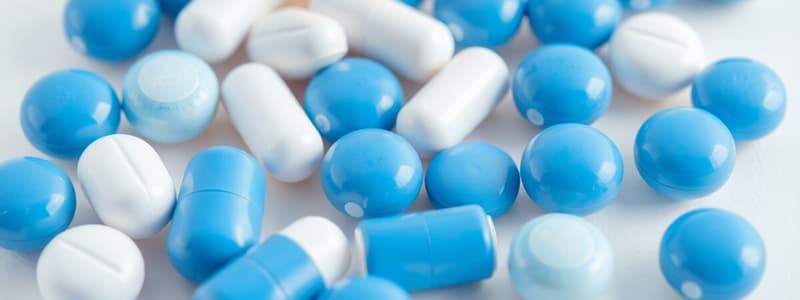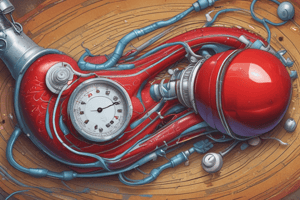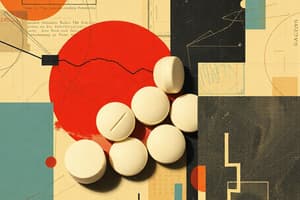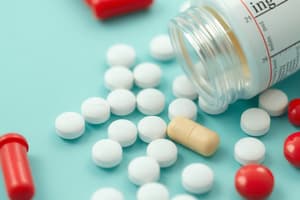Podcast
Questions and Answers
An individual's blood pressure should be measured annually starting at what age?
An individual's blood pressure should be measured annually starting at what age?
- 16 years
- 18 years (correct)
- 21 years
- 25 years
What percentage reduction in stroke risk is associated with lowering blood pressure through antihypertensive therapy?
What percentage reduction in stroke risk is associated with lowering blood pressure through antihypertensive therapy?
- 10-15%
- 35-40% (correct)
- 5-10%
- 20-25%
To ensure an accurate blood pressure reading, how long should a patient relax before the measurement is taken?
To ensure an accurate blood pressure reading, how long should a patient relax before the measurement is taken?
- Immediately prior
- 1-2 minutes
- 10 minutes
- 3-5 minutes (correct)
According to the 2017 ACC/AHA guidelines, what blood pressure reading is defined as Stage 2 hypertension?
According to the 2017 ACC/AHA guidelines, what blood pressure reading is defined as Stage 2 hypertension?
According to the ACC/AHA guidelines, what is the recommended blood pressure target for most patients requiring treatment?
According to the ACC/AHA guidelines, what is the recommended blood pressure target for most patients requiring treatment?
Which of the following nonpharmacologic interventions is recommended to reduce blood pressure?
Which of the following nonpharmacologic interventions is recommended to reduce blood pressure?
Essential or primary hypertension is best described as hypertension:
Essential or primary hypertension is best described as hypertension:
Which of the following drug classes works by reducing systemic vascular resistance and producing vasodilation?
Which of the following drug classes works by reducing systemic vascular resistance and producing vasodilation?
If a patient's blood pressure is >20/10 mmHg above their target, which approach is recommended for initiating pharmacotherapy?
If a patient's blood pressure is >20/10 mmHg above their target, which approach is recommended for initiating pharmacotherapy?
Which of the following medications is a thiazide diuretic?
Which of the following medications is a thiazide diuretic?
What is the mechanism of action of thiazide diuretics in lowering blood pressure?
What is the mechanism of action of thiazide diuretics in lowering blood pressure?
Which of the following is a common side effect associated with thiazide diuretics?
Which of the following is a common side effect associated with thiazide diuretics?
Which of the following should be monitored within 1-2 weeks, when initiating a thiazide diuretic?
Which of the following should be monitored within 1-2 weeks, when initiating a thiazide diuretic?
Which of the following is a contraindication to using thiazide diuretics?
Which of the following is a contraindication to using thiazide diuretics?
Which of the following best describes the mechanism of action of ACE inhibitors?
Which of the following best describes the mechanism of action of ACE inhibitors?
A known possible side effect that is unique to ACE-inhibitors is:
A known possible side effect that is unique to ACE-inhibitors is:
For what type of patient are ACE-inhibitors a preferred antihypertensive?
For what type of patient are ACE-inhibitors a preferred antihypertensive?
How do Angiotensin II Receptor Blockers (ARBs) lower blood pressure?
How do Angiotensin II Receptor Blockers (ARBs) lower blood pressure?
What electrolyte imbalance is a potential side effect shared by both ACE inhibitors and ARBs?
What electrolyte imbalance is a potential side effect shared by both ACE inhibitors and ARBs?
A patient who previously experienced angioedema while taking an ACE inhibitor should NOT be prescribed which of the following medications?
A patient who previously experienced angioedema while taking an ACE inhibitor should NOT be prescribed which of the following medications?
How do dihydropyridine calcium channel blockers lower blood pressure?
How do dihydropyridine calcium channel blockers lower blood pressure?
Which of the following is a common side effect of dihydropyridine calcium channel blockers?
Which of the following is a common side effect of dihydropyridine calcium channel blockers?
Non-dihydropyridine calcium channel blockers have which of the following effects in addition to lowering blood pressure?
Non-dihydropyridine calcium channel blockers have which of the following effects in addition to lowering blood pressure?
A patient with heart failure and bradycardia should avoid:
A patient with heart failure and bradycardia should avoid:
A patient with hypertension and a known sulfa allergy should avoid:
A patient with hypertension and a known sulfa allergy should avoid:
What is a key difference between ACE inhibitors and ARBs that informs prescribing decisions?
What is a key difference between ACE inhibitors and ARBs that informs prescribing decisions?
Which of the following medication instructions should be given to a patient that is prescribed a beta blocker?
Which of the following medication instructions should be given to a patient that is prescribed a beta blocker?
Which of the following patients should NOT take a beta blocker?
Which of the following patients should NOT take a beta blocker?
How do alpha-2 agonists, such as clonidine, lower blood pressure?
How do alpha-2 agonists, such as clonidine, lower blood pressure?
Which of the following is a serious side effect associated with the abrupt discontinuation of clonidine?
Which of the following is a serious side effect associated with the abrupt discontinuation of clonidine?
Which of the following best describes the mechanism of action of hydralazine in lowering blood pressure?
Which of the following best describes the mechanism of action of hydralazine in lowering blood pressure?
Which of the following is a potential side effect of hydralazine?
Which of the following is a potential side effect of hydralazine?
Which of the following diuretics is most appropriate for the treatment of hypertension?
Which of the following diuretics is most appropriate for the treatment of hypertension?
A patient presents with hypertension and is also being treated for heart failure. Which class of diuretics should be avoided in this patient?
A patient presents with hypertension and is also being treated for heart failure. Which class of diuretics should be avoided in this patient?
According to guidelines, what is the upper limit for sodium intake?
According to guidelines, what is the upper limit for sodium intake?
What should the nurse consider prior to blood pressure measurement?
What should the nurse consider prior to blood pressure measurement?
What circumference arm would need a large adult cuff?
What circumference arm would need a large adult cuff?
If initiating 2 first-line agents for blood pressure control, which agents should not be used together?
If initiating 2 first-line agents for blood pressure control, which agents should not be used together?
A patient with a history of angioedema is prescribed an antihypertensive. Which of the following medications would be most appropriate?
A patient with a history of angioedema is prescribed an antihypertensive. Which of the following medications would be most appropriate?
Which of the following is a potential adverse effect that requires monitoring when initiating a patient on chlorthalidone?
Which of the following is a potential adverse effect that requires monitoring when initiating a patient on chlorthalidone?
Which antihypertensive medication is considered a preferred first-line agent specifically for patients with concomitant diabetes and albuminuria?
Which antihypertensive medication is considered a preferred first-line agent specifically for patients with concomitant diabetes and albuminuria?
A patient is started on lisinopril for hypertension. What specific side effect should the patient be educated about that is unique to ACE inhibitors?
A patient is started on lisinopril for hypertension. What specific side effect should the patient be educated about that is unique to ACE inhibitors?
Why are non-dihydropyridine calcium channel blockers like diltiazem and verapamil typically avoided in patients with heart failure?
Why are non-dihydropyridine calcium channel blockers like diltiazem and verapamil typically avoided in patients with heart failure?
According to the ACC/AHA guidelines, what blood pressure reading would necessitate initiating BP-lowering medication for a patient with diabetes?
According to the ACC/AHA guidelines, what blood pressure reading would necessitate initiating BP-lowering medication for a patient with diabetes?
What is the primary mechanism by which aldosterone antagonists, such as spironolactone, lower blood pressure?
What is the primary mechanism by which aldosterone antagonists, such as spironolactone, lower blood pressure?
A patient on hydrochlorothiazide (HCTZ) develops hypokalemia. What intervention would directly address this side effect while continuing HCTZ?
A patient on hydrochlorothiazide (HCTZ) develops hypokalemia. What intervention would directly address this side effect while continuing HCTZ?
Which of the following dietary modifications would be most beneficial for a patient newly diagnosed with hypertension?
Which of the following dietary modifications would be most beneficial for a patient newly diagnosed with hypertension?
What is the primary mechanism by which loop diuretics, like furosemide, reduce blood pressure, particularly in the context of heart failure?
What is the primary mechanism by which loop diuretics, like furosemide, reduce blood pressure, particularly in the context of heart failure?
For a patient with hypertension and a stable ischemic heart disease, which of the following antihypertensive classes would be most appropriate as a first-line option?
For a patient with hypertension and a stable ischemic heart disease, which of the following antihypertensive classes would be most appropriate as a first-line option?
A patient abruptly stops taking clonidine. What potentially serious adverse effect should the healthcare provider be most concerned about?
A patient abruptly stops taking clonidine. What potentially serious adverse effect should the healthcare provider be most concerned about?
Which of the following best describes the action of hydralazine in lowering blood pressure?
Which of the following best describes the action of hydralazine in lowering blood pressure?
Which of the following is a common side effect associated with dihydropyridine calcium channel blockers like amlodipine?
Which of the following is a common side effect associated with dihydropyridine calcium channel blockers like amlodipine?
According to guideline recommendations, what is the blood pressure target for most patients receiving antihypertensive treatment?
According to guideline recommendations, what is the blood pressure target for most patients receiving antihypertensive treatment?
What is a key consideration when selecting an antihypertensive medication for a black patient, according to the information?
What is a key consideration when selecting an antihypertensive medication for a black patient, according to the information?
What is a critical monitoring parameter for patients taking ACE inhibitors or ARBs, especially within the first few weeks of initiation or dose change?
What is a critical monitoring parameter for patients taking ACE inhibitors or ARBs, especially within the first few weeks of initiation or dose change?
Which situation would warrant initiation of two first-line antihypertensive agents simultaneously?
Which situation would warrant initiation of two first-line antihypertensive agents simultaneously?
Which diuretic is considered less effective in patients with a CrCl (Creatinine Clearance) < 30ml/min?
Which diuretic is considered less effective in patients with a CrCl (Creatinine Clearance) < 30ml/min?
Which parameter signifies a blood pressure reading that is considered 'elevated' according to the guidelines?
Which parameter signifies a blood pressure reading that is considered 'elevated' according to the guidelines?
When is a patient with hypertension typically considered for treatment with an aldosterone antagonist (like spironolactone or eplerenone)?
When is a patient with hypertension typically considered for treatment with an aldosterone antagonist (like spironolactone or eplerenone)?
What advice should be provided to a patient taking a beta blocker regarding discontinuation of the medication?
What advice should be provided to a patient taking a beta blocker regarding discontinuation of the medication?
Which of the following is NOT correct regarding thiazide diuretics?
Which of the following is NOT correct regarding thiazide diuretics?
For a 52 year old male with repeat blood pressure of 135/78 mmHg, no prior hx of HTN or other medical conditions, no current HTN medications, and a calculated ASCVD Risk of 15%, what would you treat with first?
For a 52 year old male with repeat blood pressure of 135/78 mmHg, no prior hx of HTN or other medical conditions, no current HTN medications, and a calculated ASCVD Risk of 15%, what would you treat with first?
Flashcards
Hypertension Clinical Presentation
Hypertension Clinical Presentation
High blood pressure is often the only sign, frequently asymptomatic.
Hypertension Diagnosis
Hypertension Diagnosis
Individuals 18+ should be screened yearly. Diagnosis based on the average of two or more readings taken 1-2 minutes apart AND elevated readings at two or more visits spaced 1-4 weeks apart.
Thiazide Diuretics: Action
Thiazide Diuretics: Action
Inhibit sodium-chloride transporter in distal tubule in the kidney increasing sodium and chloride excretion. More effective at blood pressure control.
Thiazide Diuretics Examples
Thiazide Diuretics Examples
Signup and view all the flashcards
ACE Inhibitors: Action
ACE Inhibitors: Action
Signup and view all the flashcards
ARBs: Action
ARBs: Action
Signup and view all the flashcards
Calcium Channel Blockers: Action
Calcium Channel Blockers: Action
Signup and view all the flashcards
Aldosterone Antagonist Diuretics: Action
Aldosterone Antagonist Diuretics: Action
Signup and view all the flashcards
Potassium-Sparing Diuretics: Action
Potassium-Sparing Diuretics: Action
Signup and view all the flashcards
Loop Diuretics: Action
Loop Diuretics: Action
Signup and view all the flashcards
Beta Blockers: Action
Beta Blockers: Action
Signup and view all the flashcards
Alpha-2 Agonists: Action
Alpha-2 Agonists: Action
Signup and view all the flashcards
Vasodilators: Action
Vasodilators: Action
Signup and view all the flashcards
Calcium Channel Blockers
Calcium Channel Blockers
Signup and view all the flashcards
ACE inhibitors, ARBs
ACE inhibitors, ARBs
Signup and view all the flashcards
Calcium Channel Blockers
Calcium Channel Blockers
Signup and view all the flashcards
Treating Hypertension
Treating Hypertension
Signup and view all the flashcards
Blood Pressure Treatment Goal
Blood Pressure Treatment Goal
Signup and view all the flashcards
Angiotensin receptor blockers (ARBs)
Angiotensin receptor blockers (ARBs)
Signup and view all the flashcards
Spironolactone
Spironolactone
Signup and view all the flashcards
ACE Inhibitors: Side Effects
ACE Inhibitors: Side Effects
Signup and view all the flashcards
ARBs: Side Effects
ARBs: Side Effects
Signup and view all the flashcards
Dihydropyridine Calcium Channel Blockers: Side Effects
Dihydropyridine Calcium Channel Blockers: Side Effects
Signup and view all the flashcards
Non-dihydropyridine Calcium Channel Blockers: Side Effects
Non-dihydropyridine Calcium Channel Blockers: Side Effects
Signup and view all the flashcards
Aldosterone Antagonist Diuretics: Side Effects
Aldosterone Antagonist Diuretics: Side Effects
Signup and view all the flashcards
Potassium-Sparing Diuretics: Side Effects
Potassium-Sparing Diuretics: Side Effects
Signup and view all the flashcards
Loop Diuretics: Side Effects
Loop Diuretics: Side Effects
Signup and view all the flashcards
Beta Blockers: Side Effects
Beta Blockers: Side Effects
Signup and view all the flashcards
Alpha-2 Agonists: Side Effects
Alpha-2 Agonists: Side Effects
Signup and view all the flashcards
Vasodilators: Side Effects
Vasodilators: Side Effects
Signup and view all the flashcards
Study Notes
- Antihypertensive medications will be reviewed.
- Hypertension guidelines and the pathophysiology of hypertension will be reviewed.
- Pharmacotherapy targets will be identified.
- First-line agents like ACE inhibitors, ARBs, calcium channel blockers, and thiazide diuretics will be covered.
- Other agents like beta blockers, diuretics, alpha-2 agonists, and vasodilators will be discussed.
- Case studies will be examined.
Lecture Objectives
- Pharmacology and mechanism of action of antihypertensive medications will be described.
- Common and serious side effects of antihypertensive medications will be identified.
- Monitoring parameters of antihypertensive medications will be listed.
- Medication selection based on patient medical history and co-morbidities will be discussed.
Hypertension Clinical Presentation
- Elevated blood pressure is often the only sign.
- It is often asymptomatic.
- Signs and symptoms may arise due to cardiovascular, cerebrovascular, retinal, and renal complications of disease.
- Hypertension is "the silent killer."
- 7 out of 10 people who have a first heart attack have high blood pressure.
- 8 out of 10 people who have a first stroke have high blood pressure.
- 7 out of 10 people who have chronic heart failure have high blood pressure.
Diagnosis and Goals
- All individuals age 18+ should be screened for hypertension yearly.
- Diagnoses of hypertension is based on the average of two or more properly measured blood pressure readings taken 1-2 minutes apart.
- Blood pressure must be elevated when measured at two or more visits spaced 1-4 weeks apart.
- Individuals with HTN emergency (≥180/120mmHg or ≥160/100mmHg with known end-organ damage) are an exception.
- Blood pressure lowering: antihypertensive therapy is associated with a 35-40% reduction in stroke, 20-25% reduction in myocardial infarction, and >50% reduction in heart failure.
- ACC/AHA guidelines include American College of Cardiology and American Heart Association.
- The 2017 ACC/AHA guidelines includes ASCVD risk scoring.
- There is direction on screening for masked or white coat hypertension with the 2017 ACC/AHA guidelines.
Blood Pressure Monitoring
- Monitoring technique to ensure an accurate reading should include:
- Quiet room, comfortable temperature.
- No smoking, coffee, or exercise for 30 minutes.
- Empty bladder and relaxing for 3-5 minutes.
- Take 3 measurements at 1-minute intervals, use the average of the last 2 measurements. When reading blood pressure, the patient should have their back supported, should not be speaking and the arm bare and resting at heart level. A proper cuff size matters when reading blood pressure
- Small Adult recommended for 22-26 cm measurement
- Standard Adult recommended for 27-34 cm measurement
- Large Adult recommended for 35-44 cm measurement
- Thigh size recommended for >45 cm measurement
Studying That Suits You
Use AI to generate personalized quizzes and flashcards to suit your learning preferences.





